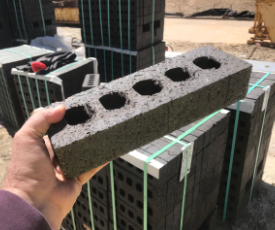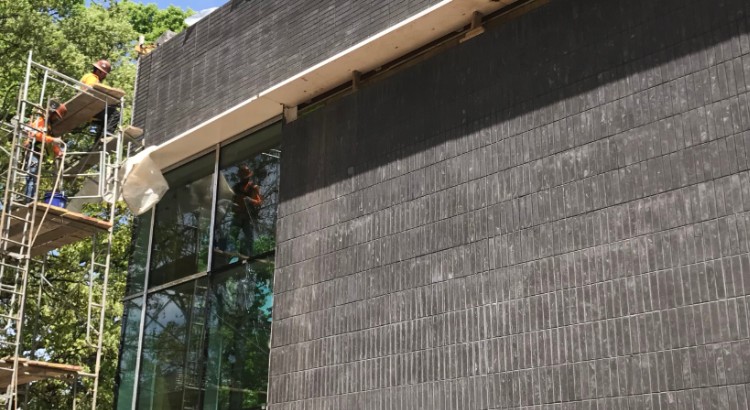 James Kolodziey wasn’t looking to reinvent the brick as a sustainable product. He’d never manufactured a masonry unit nor was he driven to be become an environmental revolutionary.
James Kolodziey wasn’t looking to reinvent the brick as a sustainable product. He’d never manufactured a masonry unit nor was he driven to be become an environmental revolutionary.
But one thing Kolodziey knew was manufacturing processes. And he had a lot of experience brokering leftover materials from one industry for use in another.
So in the early 2000s, when a North Carolina masonry plant gave up on an effort to incorporate Duke Energy’s coal ash waste into a new line of its products, it turned to the Charlotte businessman to come up with another brick that would rely on industrial waste.
Kolodziey saw the opportunity. Among the buyers of specialty starches that he marketed as part of his main business were ceramic plants that dot the North Carolina landscape.
“I looked at what my customers were throwing away,” he recalls. “They were landfilling tons and tons of industrial-grade ceramics every month.”
Could that waste be used in a brick composed entirely of recycled materials? It turns out that most of the other recycled ingredients Kolodziey needed were readily available on the North Carolina Piedmont.
“This area has the ceramic waste,” he notes. “It has the binding material waste. It has the manufacturing waste.”
Kolodziey partnered with a materials engineer, and worked with the brick factory to come up with a supply chain and a manufacturing process for 100 percent recycled brick.
“We evaluated dozens and dozens of inputs before we settled,” he says. “This is really, really, really hard to do. It is the nexus of art and science coming together.”

He guards some of the materials and processes that he and his partners came up. But he does allow that — in addition to ceramic waste — Green Leaf Bricks may include clay “overburden” from sand mines, waste from industrial filters and even wastewater solids. After going through proprietary processes, the material is formed into bricks and fired in a kiln fueled mainly by natural gas.
Other innovators have attempted to address the energy intensity of brick making. A Wisconsin company called Calstar attracted a heap of venture capital around the same time Green Leaf got started. For a time, Calstar manufactured brick while relying on about a sixth the energy of conventional kiln-baked brick. But that company went belly-up in 2015.
Kolodziey is convinced that bricks will always have to be fired. “There is no way of getting around that,” he argues.
Clay-based brick, he notes, isn’t given full credit for a significant environmental attribute: Its longevity. It’s far more durable than cinder block or fiber cement, for example, a fact that brick advocates say should be factored into lifecycle assessments for carbon and other sustainability factors.
Regardless of the energy issue, Green Leaf’s replacement of raw materials with recycled materials is a significant environmental step forward. Kolodziey stresses not only that all the materials are recycled but also that 15 to 31 percent of the materials come from the even higher value post-consumer waste stream.
Green Leaf has worked hard to fit its sustainable brick into an appropriate market niche. Like many high-end brick lines, Green Leaf’s manufacturing method is more labor-intensive than the standardized, automated conventional processes.
“We make our brick per order,” he says. “Everything is custom. So there’s a lot of human labor involved. … The owner of the plant happens a very progressive, dynamic individuals who likes to take chances and do new things.”
The resulting “through-body brick” (meaning the color is the same all the way through) and the sustainable qualities allow Green Leaf to compete on the mid-level architectural brick market. With a goal of moving fewer than 10 million units a year, the company is a small enough player to fulfill its capacity with custom orders.
“I have other businesses,” Kolodziey says. “This one is my favorite thing in the world. I love being part of something new. I love working with the architects. I love doing something for the environment.”
Product basics: Green Leaf Brick
Company: Green Leaf is a product line of the Red Tree Group, which is a privately held company. The company contracts with a North Carolina masonry plant to manufacturer the brick, using materials and processes developed by the Red Tree Group.
Kendeda Building subcontractor: Cronos Contractors (brickmasons).
Sustainability features: According to the company, Green Leaf Brick is composed entirely of recycled content, and it contains no Red List ingredients. Fifteen to 31 percent of the content is post-consumer recycled (the product used on the Kendeda Building (contains 31 percent post-consumer recycled content). According to Kolodziey, all materials are sourced from within 500 miles and 95 percent from with the state of North Carolina.
Product used in the Kendeda Building: Green Leaf’s Black Special architectural brick is comprised entirely of recycled materials, of which 31 percent is classified as post-consumer recycled materials.
PHOTO AT TOP: A mason checks the level of Green Leaf Brick on the Kendeda Building. Photo by Ken Edelstein.


